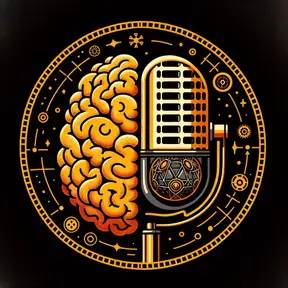The Risk Paradox: Why We Fear Sharks But Text While Driving
Why Humans Struggle with Risk Assessment: Understanding Our Cognitive Biases
In this episode of PsyberSpace, host Leslie Poston digs into the complexities of human risk assessment. Despite relying on this critical cognitive skill every day, humans often misjudge risks due to emotional biases, misinformation, and stress. From relationships and work to financial decisions and global crises like Covid-19, Leslie explores how attachment styles, behavioral economics, media influence, and neurological factors impact our perception of risk. The episode also offers practical strategies for improving risk literacy and making more informed decisions in various aspects of life, emphasizing the importance of probabilistic thinking, cleaning up our information diet, and leveraging social perspectives. Tune in to learn how to navigate uncertainty with greater clarity and confidence.
00:00 Introduction to Risk Assessment
01:46 Relationship Risks and Attachment Styles
03:35 Workplace and Financial Risk Misjudgments
04:46 Psychological Biases in Risk Perception
10:40 Media's Role in Distorting Risk Perception
13:43 Impact of Covid on Risk Assessment
17:06 Political and Cultural Influences on Risk
20:21 Improving Your Risk Assessment Skills
23:58 Conclusion and Final Thoughts
References:
In this episode of PsyberSpace, host Leslie Poston digs into the complexities of human risk assessment. Despite relying on this critical cognitive skill every day, humans often misjudge risks due to emotional biases, misinformation, and stress. From relationships and work to financial decisions and global crises like Covid-19, Leslie explores how attachment styles, behavioral economics, media influence, and neurological factors impact our perception of risk. The episode also offers practical strategies for improving risk literacy and making more informed decisions in various aspects of life, emphasizing the importance of probabilistic thinking, cleaning up our information diet, and leveraging social perspectives. Tune in to learn how to navigate uncertainty with greater clarity and confidence.
00:00 Introduction to Risk Assessment
01:46 Relationship Risks and Attachment Styles
03:35 Workplace and Financial Risk Misjudgments
04:46 Psychological Biases in Risk Perception
10:40 Media's Role in Distorting Risk Perception
13:43 Impact of Covid on Risk Assessment
17:06 Political and Cultural Influences on Risk
20:21 Improving Your Risk Assessment Skills
23:58 Conclusion and Final Thoughts
References:
Bavel, J. J. V., Baicker, K., Boggio, P. S., Capraro, V., Cichocka, A., Cikara, M., Crockett, M. J., Crum, A. J., Douglas, K. M., Druckman, J. N., Drury, J., Dube, O., Ellemers, N., Finkel, E. J., Fowler, J. H., Gelfand, M., Han, S., Haslam, S. A., Jetten, J., ... Willer, R. (2020). Using social and behavioural science to support COVID-19 pandemic response. Nature Human Behaviour, 4(5), 460-471.
Fischhoff, B., & Broomell, S. B. (2020). Judgment and decision making. Annual Review of Psychology, 71, 331-355.
Chong, J. Y., Anderson, G. M., & Fraley, R. C. (2024). Natural clues to danger: Attachment behavior in threatening situations. Attachment & Human Development, 26(4), 366–382.
Chong, J. Y., Anderson, G. M., & Fraley, R. C. (2024). Natural clues to danger: Attachment behavior in threatening situations. Attachment & Human Development, 26(4), 366–382.
Gigerenzer, G. (2015). Risk savvy: How to make good decisions. Penguin.
Kahneman, D. (2011). Thinking, fast and slow. Farrar, Straus and Giroux.
Lerner, J. S., Li, Y., Valdesolo, P., & Kassam, K. S. (2015). Emotion and decision making. Annual Review of Psychology, 66, 799-823.
Slovic, P. (2016). The perception of risk. Routledge.
Sunstein, C. R. (2020). How change happens. MIT Press.
Tversky, A., & Kahneman, D. (1974). Judgment under uncertainty: Heuristics and biases. Science, 185(4157), 1124-1131.
Feeney, J. A., & Karantzas, G. C. (2017). Couple conflict: Insights from an attachment perspective. Current Opinion in Psychology, 13, 60-64.
Hazan, C., & Shaver, P. R. (1994). Attachment as an organizational framework for research on close relationships. Psychological Inquiry, 5(1), 1-22.
Mikulincer, M., & Shaver, P. R. (2016). Attachment in adulthood: Structure, dynamics, and change (2nd ed.). Guilford Press.
Simpson, J. A., & Rholes, W. S. (2017). Adult attachment, stress, and romantic relationships. Current Opinion in Psychology, 13, 19-24.
Benartzi, S., & Thaler, R. H. (2013). Behavioral economics and the retirement savings crisis. Science, 339(6124), 1152-1153.
Cheng, Y. Y., Shein, P. P., & Chiou, W. B. (2012). Escaping the impulse to immediate gratification: The prospect concept promotes a future-oriented mindset, prompting an inclination towards delayed gratification. British Journal of Psychology, 103(1), 129-141
Loewenstein, G., & Prelec, D. (1992). Anomalies in intertemporal choice: Evidence and an interpretation. The Quarterly Journal of Economics, 107(2), 573-597.
Thaler, R. H., & Sunstein, C. R. (2021). Nudge: The final edition. Penguin Books.
Binder, A. R., Cacciatore, M. A., Scheufele, D. A., & Brossard, D. (2015). The role of news media in the social amplification of risk. In The SAGE handbook of risk communication (pp. 69-85). SAGE Publications.
Covello, V. T., & Sandman, P. M. (2001). Risk communication: Evolution and revolution. In Solutions to an environment in peril (pp. 164-178). Johns Hopkins University Press.
Nelkin, D. (1989). Communicating technological risk: The social construction of risk perception. Annual Review of Public Health, 10(1), 95-113.
Wahl-Jorgensen, K. (2019). Emotions, media, and politics. Polity Press.
Douaud, G., Lee, S., Alfaro-Almagro, F., Arthofer, C., Wang, C., McCarthy, P., Lange, F., Andersson, J. L. R., Griffanti, L., Duff, E., Jbabdi, S., Taschler, B., Keating, P., Winkler, A. M., Collins, R., Matthews, P. M., Allen, N., Miller, K. L., Nichols, T. E., & Smith, S. M. (2022). SARS-CoV-2 is associated with changes in brain structure in UK Biobank. Nature, 604(7907), 697-707.
Hampshire, A., Trender, W., Chamberlain, S. R., Jolly, A. E., Grant, J. E., Patrick, F., Mazibuko, N., Williams, S. C., Barnby, J. M., Hellyer, P., & Mehta, M. A. (2021). Cognitive deficits in people who have recovered from COVID-19. EClinicalMedicine, 39, 101044.
Taquet, M., Geddes, J. R., Husain, M., Luciano, S., & Harrison, P. J. (2021). 6-month neurological and psychiatric outcomes in 236 379 survivors of COVID-19: a retrospective cohort study using electronic health records. The Lancet Psychiatry, 8(5), 416-427.
Whitaker, M., Elliott, J., Chadeau-Hyam, M., Riley, S., Darzi, A., Cooke, G., Ward, H., & Elliott, P. (2022). Persistent COVID-19 symptoms in a community study of 606,434 people in England. Nature Communications, 13(1), 1957.
Bowles, S., & Carlin, W. (2020). Shrinking capitalism. AEA Papers and Proceedings, 110, 372-377.
Fiorina, M. P. (2017). Unstable majorities: Polarization, party sorting, and political stalemate. Hoover Institution Press.
Persily, N., & Tucker, J. A. (Eds.). (2020). Social media and democracy: The state of the field, prospects for reform. Cambridge University Press.
Sunstein, C. R. (2018). #Republic: Divided democracy in the age of social media. Princeton University Press.
Zuboff, S. (2019). The age of surveillance capitalism: The fight for a human future at the new frontier of power. Public Affairs.
Barron, G., & Erev, I. (2003). Small feedback-based decisions and their limited correspondence to description-based decisions. Journal of Behavioral Decision Making, 16(3), 215-233.
Dhami, M. K., Schlottmann, A., & Waldmann, M. R. (Eds.). (2011). Judgment and decision making as a skill: Learning, development and evolution. Cambridge University Press.
Fradera, A. (2018). Training can help people to spot the logical fallacy at the core of "fake news." The British Psychological Society Research Digest.
Hertwig, R., & Grüne-Yanoff, T. (2017). Nudging and boosting: Steering or empowering good decisions. Perspectives on Psychological Science, 12(6), 973-986.
★ Support this podcast ★
Creators and Guests


